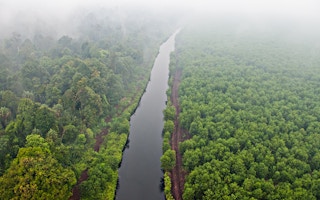Indonesia’s widely-publicised efforts to restore its peatlands may have been overstated, meaning that vast areas of the carbon-rich soil are vulnerable to burning as a dry season exacerbated by the El Niño weather phenomenon approaches, a new study finds.
Indonesia’s government claims to have restored some 3.66 million hectares of peatlands that were destroyed in the apocalyptic fires of 2015, which over a suffocating two-month period produced more carbon emissions per day than the carbon footprint of the United States economy.
Large swathes of Indonesia’s 20 million hectares of peat are prone to fire having been drained to grow cash crops such as palm oil and pulpwood. After the 2015 haze that choked most of its Southeast Asian neighbours, the Indonesian government pledged to restore millions of hectares of degraded peatlands to prevent future fires.
However, analysis by The Gecko Project, a non-profit that investigates land-use issues, finds that much of the peatlands the authorities claim to have restored may actually be vulnerable to the fires that are estimated to have caused 100,000 premature deaths from toxic “haze” pollution eight years ago.
Indonesia’s Ministry of Environment and Forestry (KLHK) claims that 3.66 million ha of peatland have been restored. But what KLHK apparently considers to be “restored” peatland – when the groundwater level of the peat has been raised to 40 centimetres below the surface through a process known as “rewetting” – reaches across a much smaller area, according to analysis of official data by The Gecko Project.
Since 2019, some 2.7 million ha of peatlands have been rewetted to a level KLHK considered sufficiently hydrated – significantly below the 3.66 million ha declared as restored, the investigation finds.
According to the analysis, the restored area of peatland has not increased since 2019, while water levels of the peatlands have not been maintained at stable levels, with large fluctuations in water levels recorded between 2019 and 2022.
In many areas where restoration work has been carried out, other methods needed to fully restore the function of a peatland, such as replanting native vegetation, appear to have been neglected, the report suggests.
A number of plantation companies operate on peatlands in which water levels have been below 40 centimetres (cm) for much of the past year, including PT Rimba Hutani Mas, a pulpwood company that supplies paper giant Asia Pulp & Paper (APP), The Gecko Report’s analysis shows.
South Sumatra-based PT Rimba Hutani Mas, which between September 2022 and April 2023 had large areas of its peat-based concession below 40 cm, was sued by Singapore’s environment agency in 2015 for causing severe air pollution in the city-state.
APP did not respond to questions from The Gecko Project about water levels in PT Rimba Hutani Mas’ concession but said it has been submitting “all the required data” to KLHK.
Another plantation company that has regularly recorded water levels below 40cm over the past year is PT Seraya Sumber Lestari, which operates in Riau province on Sumatra and supplies Asia Pacific Resources International Limited (APRIL), APP’s competitor. PT Seraya Sumber Lestari has previously been sanctioned by the Indonesian government for fires on its land.
In response to The Gecko Project’s findings, APRIL said PT Seraya Sumber Lestari keeps its peatland “moist” irrespective of water levels, and that “years of ground experience and extensive fire data indicate no correlation between water table and fire risk in well-managed plantations”.
This year, the return of the El Niño weather phenomenon risks a repeat of something like the haze of 2015, experts have warned, with slash-and-burn forestry by smallholders and the presence of large agribusiness firms operating on drained peatlands posing a chronic haze risk.
The coming months will serve as “a good test” of the government’s peatland restoration claims, David Taylor, a professor and peatland expert at the National University of Singapore, told The Gecko Project.
For more Indonesia ESG and sustainability news and views, subscribe to the Eco-Business Indonesia newsletter here.

















